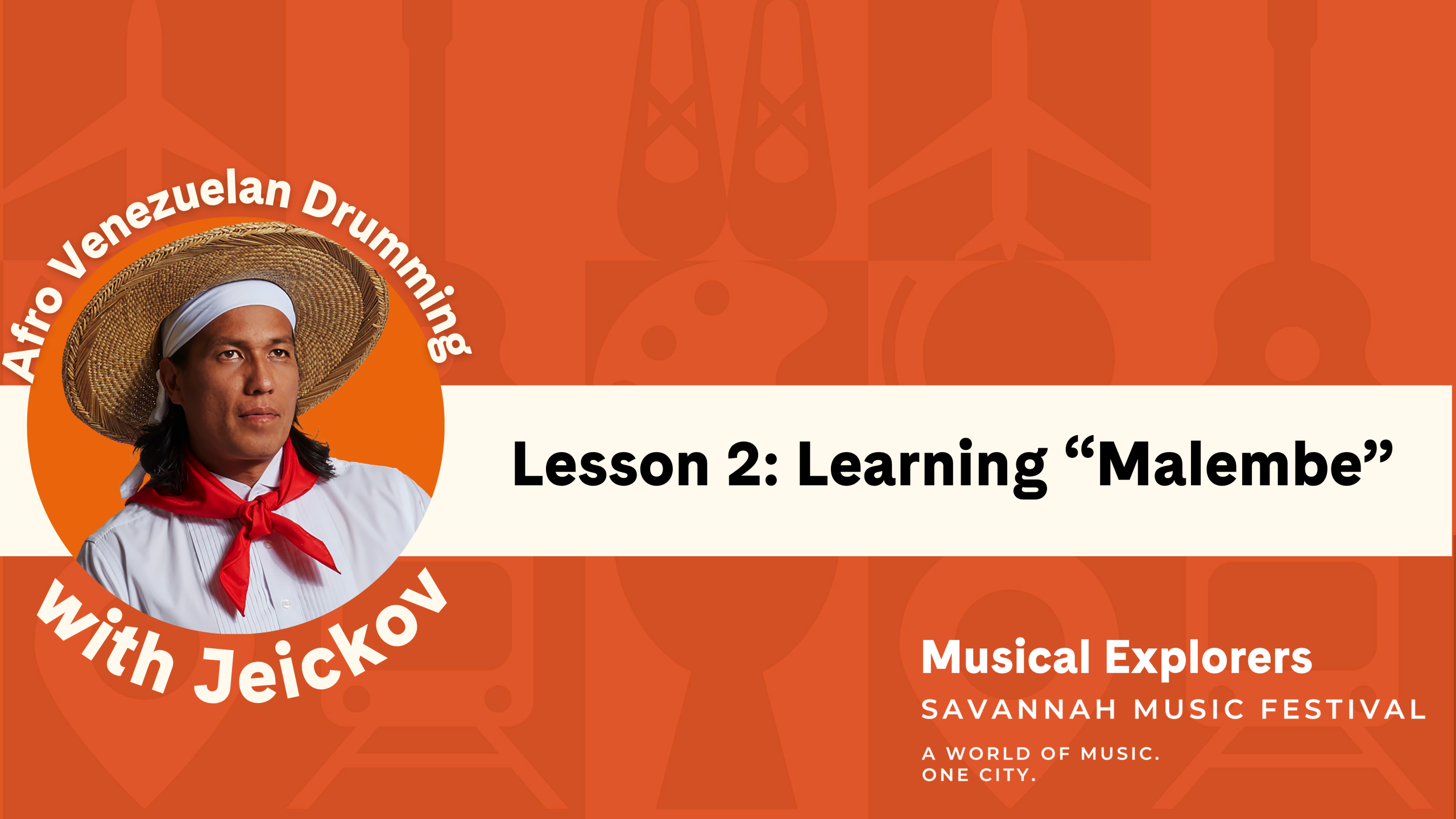Aim: How do the people of Venezuela celebrate the San Juan Festival?
Summary: Students will discover the Venezuelan holiday, Festival of San Juan, and explore ways of celebrating through music, dance, and dress
Materials: Musical Explorers online resources
Standards:GA: ESGM2.PR.1, ESGM2.RE.1, ESGM2. CN.1, ESGM2.CN.2; SC: GM.PR.NL-AH.3, GM.RE.NL-AH.6, GM.RE.NL-AH.7, GM.CN.NL-AH.8, GM.CN.NL-AH.9
Vocabulary: rhythm, sangueo, tambores culoepuya, vocable
“Malembe” is a song from the northern coast of Venezuela, performed annually during the Festival of San Juan. The Festival originated as a celebration for enslaved people and was later adopted by the Catholic Church to honor the birth of Saint John the Baptist. Today, Afro Venezuelan people all over the world celebrate the San Juan Festival, which coincides with the summer solstice, dressing in red while singing and dancing traditional songs with African origin.
Sing “Malembe”
- Listen to “Malembe,” Track 2.11.
- Raise your hand each time you hear the coro, the repeated chant.
Track 2.11 “Malembe” Song
- Explain that the coro in “Malembe” is a vocable, a melody sung without words. Learn the melody of the coro using Track 2.12.

Track 2.12 “Malembe” Coro Melody
- Once memorized, have students try different vocables while singing the melody:
- Eeeeeeee ahhhhhhh (original)
- Oooooooh eeeeeeee
- Laaaaaaa chaaaaaaa
- Boooooo baaaaaaa
Listen to “Malembe,” Track 2.11, again and have students try their vocable variations during the coro.
Track 2.11 “Malembe” Song
“Malembe”
Hay malembe malembe
malembe no ma
Coro: eeeeee aaaaaaaa
(x2)
San Juan guaricongo
cabeza pela
Coro: eeeeee aaaaaaaa
Lelelela
Coro: eeeeee aaaaaaaa
(x2)
Hay san Juan guaricongo
cabeza pela
Coro: eeeeee aaaaaaaa
Si san Juan supiera
cual fuera su dia
Coro: eeeeee aaaaaaaa
(x2)
Del cielo bajara
con gran alegría
Coro: eeeeee aaaaaaaa
Lelelele la
Coro: eeeeee aaaaaaaa
(x2)
Hay san Juan guaricongo
cabeza pela
Coro: eeeeee aaaaaaaa
El año que viene
te vuelvo a cantar
Coro: eeeeee aaaaaaaa
El año que viene
te vuelvo a bailar
Coro: eeeeee aaaaaaaa
Lelelele la
Coro: eeeeee aaaaaaaa
Hay adiós Tacarigua*
y adiós Mamporal**
Coro: eeeeee aaaaaaaa
*A city in Trinidad and Tobago
**A city in Northern Venezuela, near Caracas
There is rhythm, rhythm
Rhythm, nothing else
Coro: eeeeee aaaaaaaa
(x2)
It’s San Juan from Africa
Coro: eeeeee aaaaaaaa
Lelelela
Coro: eeeeee aaaaaaaa
(x2)
It’s San Juan from Africa
Coro: eeeeee aaaaaaaa
If San Juan knew
this would be his day
Coro: eeeeee aaaaaaaa
(x2)
From the sky, he would come down
with great joy
Coro: eeeeee aaaaaaaa
Lelelele la
Coro: eeeeee aaaaaaaa
(x2)
It’s San Juan from Africa
Coro: eeeeee aaaaaaaa
Next year
I will sing to you again
Coro: eeeeee aaaaaaaa
Next year
I will dance for you again
Coro: eeeeee aaaaaaaa
Lelelele la
Coro: eeeeee aaaaaaaa
Goodbye Tacarigua
and goodbye Mamporal
Coro: eeeeee aaaaaaaa
Learn About Rhythm in “Malembe”
- Introduce steady beat:
- The steady pulse you feel in music is called steady beat. The steady beat is like the heartbeat inthe music.
- What other things besides your heartbeat and music have a steady beat?
- Practice patting your lap while counting to 4: 1-2-3-4 and ask students to repeat. Once students are comfortable with this concept, invite students to be the “leader.”
- Change the tempo (speed) of pats and where on the body to tap the beats to mix it up. Listen to “Malembe,” Track 2.11, while patting and counting the steady beat rhythm.
- Do you hear the rhythm in “Malembe”? Is it the same or different from the rhythm we were clapping?
Track 2.11 “Malembe” Song
- Explain that there are different types of rhythms used in Afro Venezuelan music. Listen to “Malembe” again and try to clap along to the guiding rhythm of the song.

Use SG 17 for a visual display of rhythm and have students create their own.
Explore Tambores Culoepuya
- Culoepuya are a set of three long drums used in processions, celebrations, and festivals like the San Juan Festival. They are perfect for carrying around during the Festival because they are lightweight!
- Culoepuya drums are always used together as a set of three. There is a small, medium, and large culoepuya, each with a different sound quality. Using Tracks 2.13-2.15, listen to each culoepuya while making the diameter (small, medium, large) with your hands.
Track 2.13 Small Culoepuya Demo
Track 2.14 Medium Culoepuya Demo
Track 2.15 Large Culoepuya Demo
Dance and Movement at the Festival of San Juan
- Sangueo is a social dance that’s meant to be danced in a community setting with lots of people, perhaps even strangers, joining in. The dance is fast paced, matching the rhythm of the tambores, but simple so lots of people can learn quickly.
- The sangueo celebrates the Festival of San Juan through foot movement.
- Start by practicing the foot movement, which involves shifting weight from one foot to the other very quickly. Practice the step slowly at first, then get faster.
- Once you understand the basic step, you can add turns, turning around yourself or a partner. You can also make up arm and hip motions in response to a partner or the crowd.
- Listen to “Malembe,” Track 2.11, while practicing the sangueo movement. Incorporate red flags or handkerchieves into movement for students to embody the festival experience.
Track 2.11 “Malembe” Song
Musical Word Wall
Add the words rhythm, sangueo, tambores culoepuya, and vocable to the Musical Word Wall.
PDF Downloads
SG 16 – Explore the Festival of San Juan
SG 17 – Compose Your Own Festival Rhythm
Audio Tracks
Track 2.11 “Malembe” Song
Track 2.12 “Malembe” Coro Melody
Track 2.13 Small Culoepuya Demo
Track 2.15 Large Culoepuya Demo
← Previous: Unit 2 – Lesson 1: Learning “Como Suena”
Next: Unit 3 – Korean with Elena →

